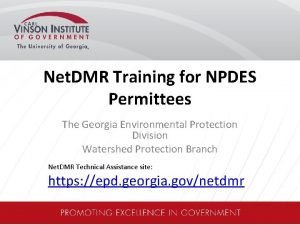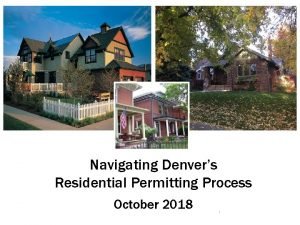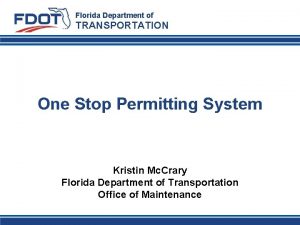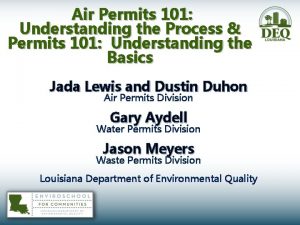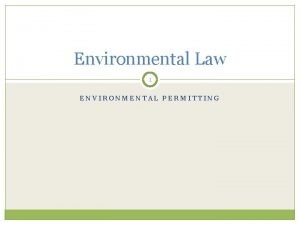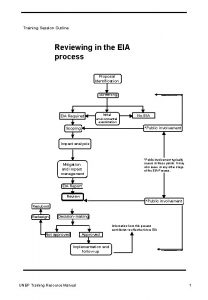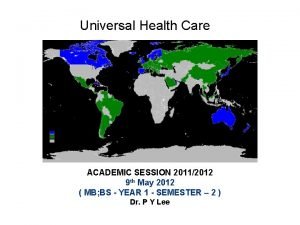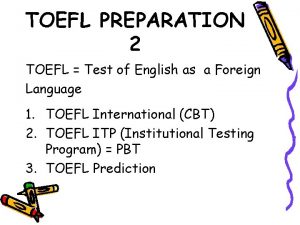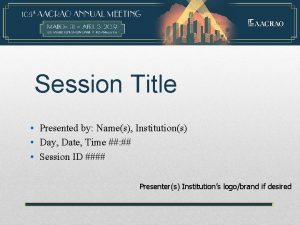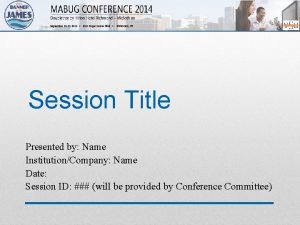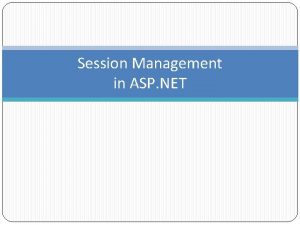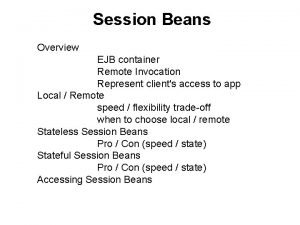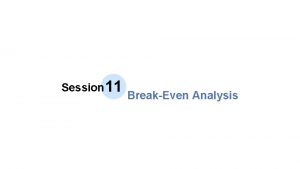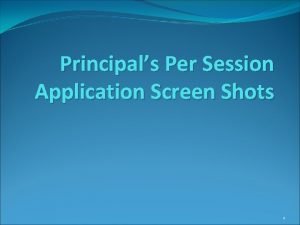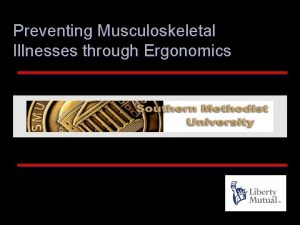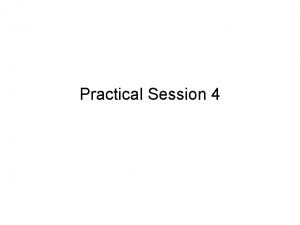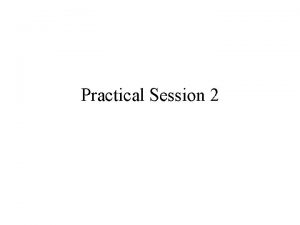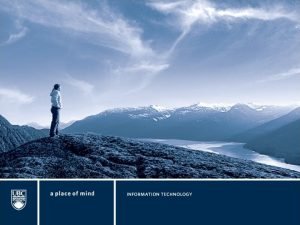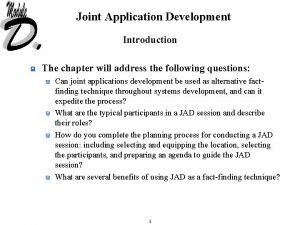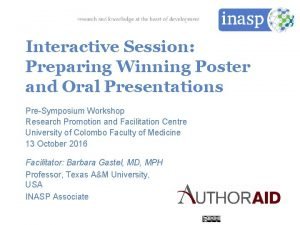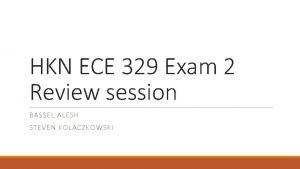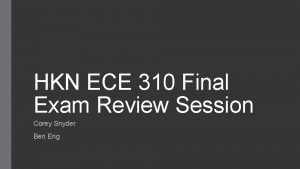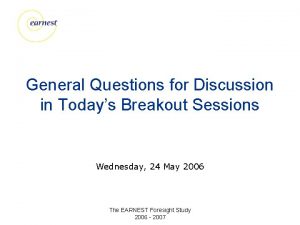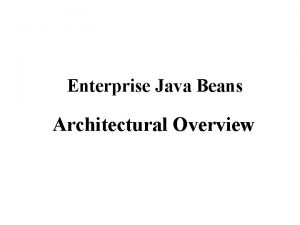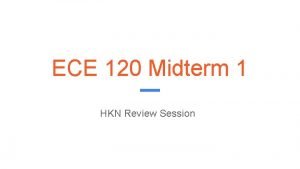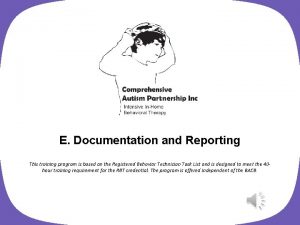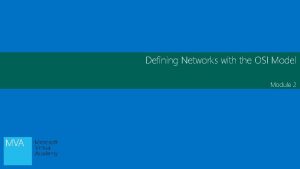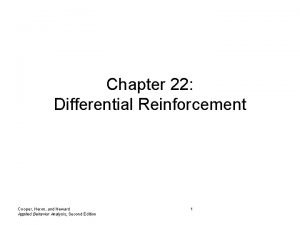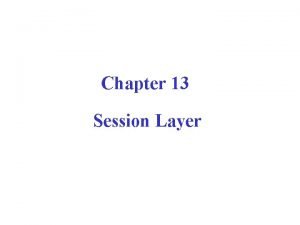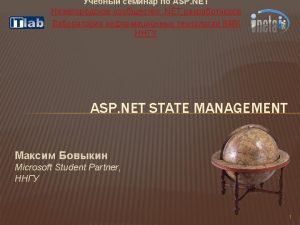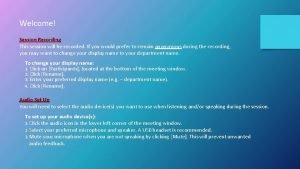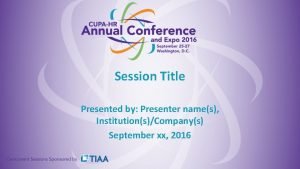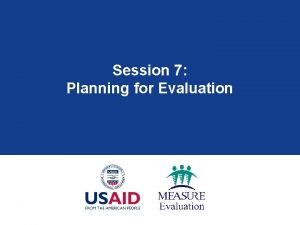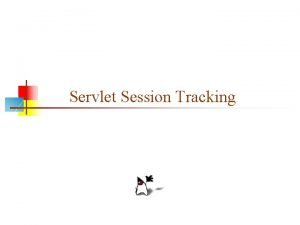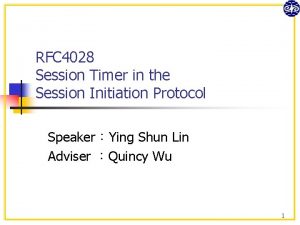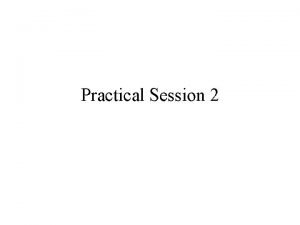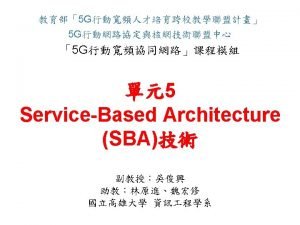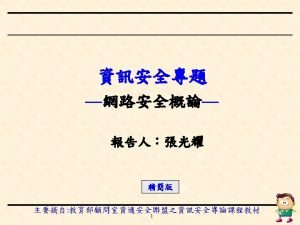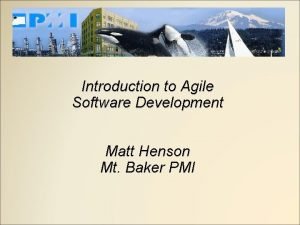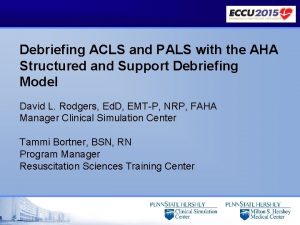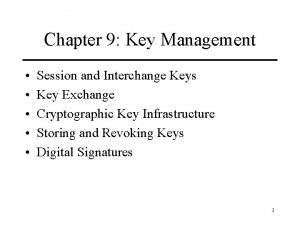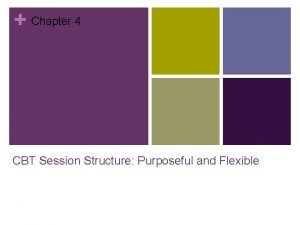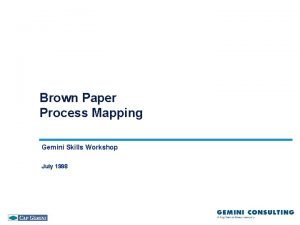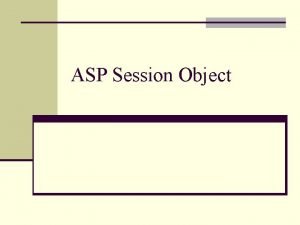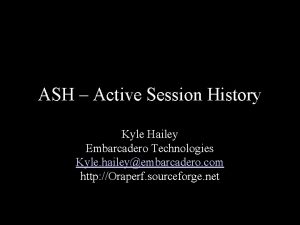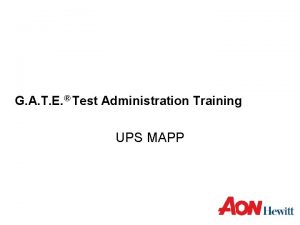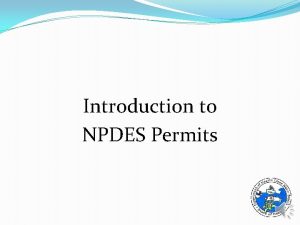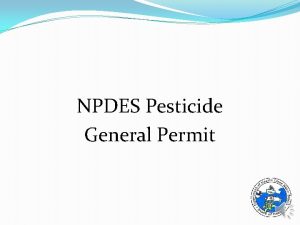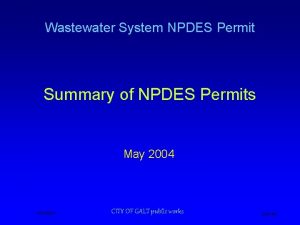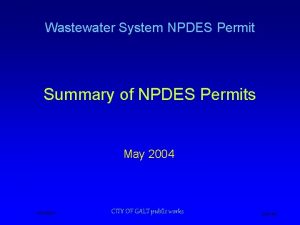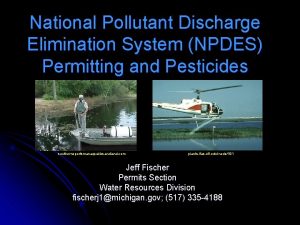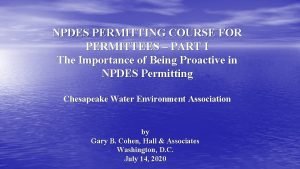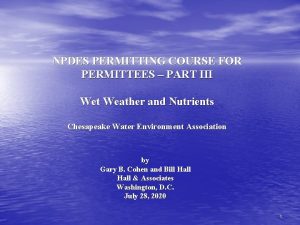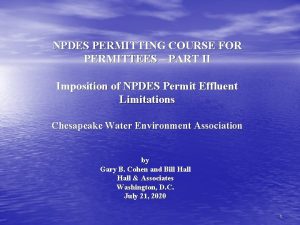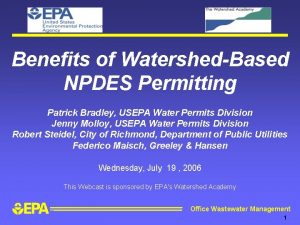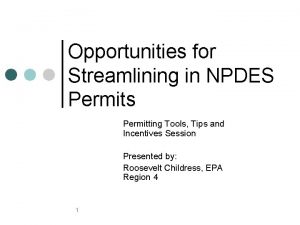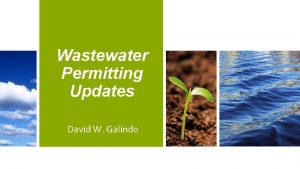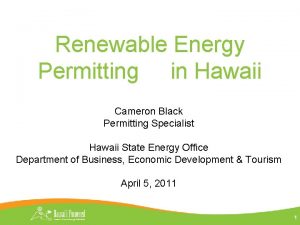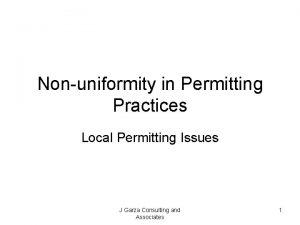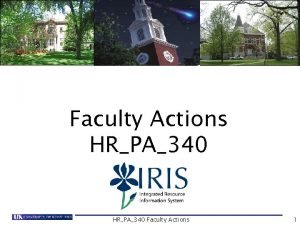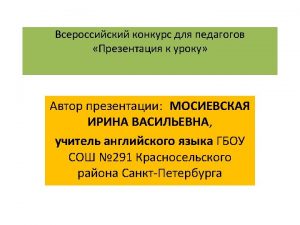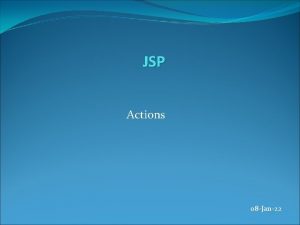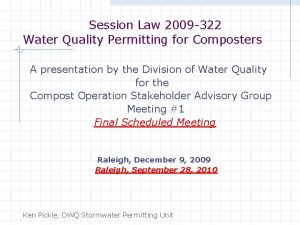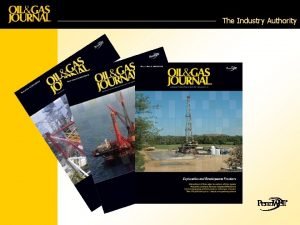Industry Training NPDES Session 2 Permitting Actions Using












































































- Slides: 76

Industry Training NPDES Session 2 Permitting Actions Using Spreadsheets May 16, 2018

Topics • • Aluminum Translator / Workbook POC Worksheet Reasonable Potential Assessment / Workbook Mixing Zones / Workbook TSD Workbooks Anti-degradation / TMDL’s BWQ Workbook

Aluminum Translator

Dissolved Aluminum • • In 2003, WV adopted a new aluminum criteria. The criteria was 750 ug/l total. The new criteria went to 87 ug/l dissolved. Major confusion and problems erupted on how to implement in permits.

Why Do We Need a Translator? By regulation (40 CFR 122. 45(c)), the limit in a NPDES permit, in most instances, must be expressed as total recoverable metal. • (c)Metals. All permit effluent limitations, standards, or prohibitions for a metal shall be expressed in terms of “total recoverable metal” as defined in 40 CFR part 136 unless: • (1) An applicable effluent standard or limitation has been promulgated under the CWA and specifies the limitation for the metal in the dissolved or valent or total form; or • (2) In establishing permit limitations on a case-by-case basis under 40 CFR 125. 3, it is necessary to express the limitation on the metal in the dissolved or valent or total form to carry out the provisions of the CWA; or • (3) All approved analytical methods for the metal inherently measure only its dissolved form (e. g. , hexavalent chromium).

DEFINITIONS • Dissolved metal is operationally defined as a metal in an unacidified sample that passes through a 0. 45 um (micron) membrane filter. • Total Recoverable Metal: The concentration of a metal in an unfiltered sample following treatment with dilute nitric acid. To determine total recoverable metal, the entire sample is acidified at the time of collection by adding 5 ml of concentrated redistilled nitric acid in one liter of the sample. Here, a less vigorous digestion procedure is utilized. • Conversion Factor - The aquatic life criteria for the metal is listed in terms of “total recoverable concentration” form in Appendix E of 47 CSR 2. It is converted to a “dissolved concentration” form by multiplying each numerical value or criterion equation from Appendix E by the appropriate conversion factor (CF) from Appendix E, Table 2.

• Conversion Factor - The aquatic life criteria for the metal is listed in terms of “total recoverable concentration” form in Appendix E of 47 CSR 2. It is converted to a “dissolved concentration” form by multiplying each numerical value or criterion equation from Appendix E by the appropriate conversion factor (CF) from Appendix E, Table 2. • Translator(f. D) is the fraction of total recoverable metal in the downstream water that is in the dissolved form. It is calculated by dividing the dissolved metal concentration (CD) by the total recoverable metal concentration(CTR ). The translator (f. D), or dissolved metal fraction, is defined as: f. D = CD /CTR

DEVELOPING A TRANSLATOR A translator can be developed under a conservative default translator procedure or through a sitespecific study of the effluent and its receiving waters. Development of a site-specific translator requires extensive field study, analytical work and data analysis. Such activities require a significant expenditure of resources by the permittee as well as the granting of time by the agency. Conversely, the default translator procedure can be implemented immediately by simply letting CF = f. D.


THE DEFAULT TRANSLATOR PROCEDURE • In a default procedure assessment where CF = f. D, the CF value for aluminum equals 1. • When f. D = 1, the dissolved value equals the total value. • Yields no benefit. • Can be problematic where the total concentration is greater that the dissolved criteria concentration.

SITE-SPECIFIC TRANSLATOR PROCEDURE Site-specific translators can be determined by: • Direct measurements of concentrations of dissolved metals and those of total recoverable metals in the receiving waters under defined critical conditions. • Indirect measurements using the partition coefficient. The partition coefficient (Kp), in turn, may be derived as a function of TSS and other relevant factors which may include, but not necessarily be limited to, p. H, POC, and humic substances.

Defining Critical Conditions • On a case-by case basis, the critical effluent and receiving stream condition must be identified, and then the dissolved/total recoverable data sets must be evaluated to determine the f. D that is applicable for limitation development. • For surface activity where the discharge flows are considered seasonal, the critical condition is considered to be “variable flow”. For pumped or gravity (deep mine) discharges, the critical condition for the receiving stream will be considered 7 Q 10. Rain gauge protocol sampling must be conducted. • Twenty (20) samples must be taken over a 10 – 12 month period of time down-stream of the permitted outlets to address variability in ambient conditions and the discharge.

DIRECT MEASUREMENT METHOD LOCATION OF SAMPLING STATIONS • Translator sampling stations shall be located after complete mixing of the discharges with the receiving stream. In most of our situations this will occur rapidly. For instance: in-stream ponds and first and second order streams that have small stream widths. • As a general matter the downstream station should be located no more than 50 feet downstream of the confluence of the most downstream discharge with the receiving stream. • Upstream stations can be located immediately upstream of the uppermost confluence of the discharge with the receiving stream. So 25 to 50 feet upstream is appropriate. In case of valley fills there is no need to establish an upstream station. • In certain situations the immediate receiving stream may not have sufficient stream flow (ephemeral) to sample. In these cases the Translator Sampling Station needs to be moved to the next receiving stream.

How & When to Sample • A minimum of twenty (20) samples must be submitted for the study. “No flow” for the stream sample will not be accepted. • The Translator Study is a 12 month study on all outlets constructed during the study period. The study period will begin at the time of the first outlet being constructed. • As a general matter, the sampling frequency for the Translator Study should be the sampling frequency as the issued NPDES Permit. The sampling should be able to capture both baseline and rainfall conditions over the 12 month sampling period. Rainfall records (rain gauge) shall be maintained, correlated with the sampling dates and submitted throughout the study period. • Sampling shall occur under various flow scenarios. If a permittee proposes to sample at the time of their routine semi-monthly sampling that is fine. The odds that they encounter precipitation events or soon after one should be good. As a general matter, between 4 to 10 samples shall be collected during base flows.

Analysis of Samples • • Dissolved Aluminum Total Suspended Solids (residue nonfilterable) Hardness p. H Flow Conductivity Temperature

Acceptable Data • Analysis must be conducted by a DEP certified lab and submitted on a certified lab sheet. Samples must be analyzed within the approved holding times and using approved EPA methodologies capable of achieving the necessary levels of detection. • If both total recoverable and dissolved aluminum concentrations are non-detect for the stream station, the data pair should be discarded. • If only the dissolved aluminum concentration is non-detect, it shall be assumed to equal one-half the detection level. • If the discharge shows non-detect for both total and dissolved aluminum and the stream station has detectable total and dissolved, the data will be OK to use.

Acceptable Data • If the majority of the data is generated at the critical condition in the receiving stream, and if the data set is log-normally distributed, and if f. D is statistically independent of TSS, then the geometric mean of translator values should be used to determine f. D. The 95 th percentile translator value should be used if the data set violates any of the aforementioned conditions. • If the data set is not log-normally distributed, alternative statistical transformations may be considered to normalize data and determine the transformed mean to be used to calculate f. D. • Regression analysis to confirm a relationship between f. D and TSS and to develop an equation that represents the relationship. It may also be used to address data sets that are not generated exclusively at critical conditions. Provided that the permit writer can determine, with 95% confidence, the TSS value applicable to the critical condition in the receiving stream, that value can be inserted into the regression equation to determine f. D.

Submitting the Study • Once the Translator Study is completed, the permittee needs to submit the study in its entirety to the DEP with their request to modify the applicable aluminum effluent limitations (Total Aluminum) in their permit with the site-specific translator. • The study must be submitted with all lab sheets and rain gauge information to document the collection and analysis. • The analysis must be submitted using the most current DEP approved translator workbook or obtain approval from HQ to use any other version.

Translator Workbook

POC Parameter of Concern


POC Example

RPA Reasonable Potential Assessment

How to Conduct a RPA Conducting a reasonable potential assessment differs depending on the type of permitting action being considered. Basically there are three types of NPDES Permitting actions that would require a Reasonable Potential Assessment. v New Permit (adding new discharges) v Modifications (Altering an existing discharge or adding new discharges) v Reissuance (Assessing existing discharges).










RP Workbooks

Mixing Zones

TITLE 47 -SERIES 2 REQUIREMENTS GOVERNING WATER QUALITY STANDARDS 5. 2. a. The Secretary will assign, on a case-by-case basis, definable geometric limits for mixing zones for a discharge or a pollutant or pollutants within a discharge. Applicable limits shall include, but may not be limited to, the linear distances from the point of discharge, surface area involvement, volume of receiving water, and shall take into account other nearby mixing zones. Mixing zones shall take into account the mixing conditions in the receiving stream (i. e: whether complete or incomplete mixing conditions exist). Mixing zones will not be allowed until applicable limits are assigned by the Secretary in accordance with this section.

Mixing Zones Shall Not: v for human health criteria, be established on a stream which has a seven (7) day, ten (10) year return frequency of 5 cfs or less. v interfere with fish spawning or nursery areas or fish migration routes. v overlap public water supply intakes or bathing areas. v cause lethality to or preclude the free passage of fish or other aquatic life v harm any threatened or endangered species v exceed one-third (1/3) of the width of the receiving stream v exceed one-half (1/2) of the cross-sectional area of the receiving stream v affect in excess of ten (10) percent of the volume of that portion of the receiving waters available for mixing In lakes and other surface impoundments

Mixing Zones Shall Not: v Be used for, or considered as, a substitute for technologybased requirements of the Act and other applicable state and federal laws. v Extend downstream at any time a distance more than five times the width of the receiving watercourse at the point of discharge. v Cause or contribute to any of the conditions prohibited in § 47 -2 -3. Conditions Not Allowable In State Waters v Be granted where instream waste concentration of a discharge is greater than 80%. v Overlap one another. v Overlap any 1/2 mile zone described in section 7. 2. a. 2 cover public water supplies.

It is also inappropriate to grant a mixing zone where upstream water quality is in violation of an applicable standard for a pollutant. Mixing zones cannot be granted for the pollutant(s) in violation. Exceedance of a standard for an individual parameter does not preclude the granting of a mixing zone for other pollutants. Assessment of upstream water quality should be performed in the immediate upstream vicinity of the discharge. If, at the discharge location, a receiving stream has recovered from an upstream water quality standard violation, then a mixing zone should not be disallowed based upon the upstream violation.

Need to monitor water quality after the mix. Need the 7 Q 10 flow and concentration of upstream parameters USMS DSMS New 002 001 Use average flow for valley fills or use the max flow from pump or gravity flow.

Mixing Zone Spreadsheet Example

T echnical S upport D ocument





DWWM TSD WORKSHEET

ANTIDEGRADATION

Anti-degradation q New or expanded q Parameters of Concern q Baseline Water Quality (BWQ) q Tier Protection q Less Degrading Alternatives q Significant Degradation – Social Economic Importance 49

WHAT IS ANTIDEGRADATION ? • The Clean Water Act mandated that states develop an antidegradation policy to protect waters beyond state water quality standards. • Implementation of the Anti-degradation rule TITLE 60 SERIES 5 provides protection through the expanded collection and review of existing water quality and water uses, additional emphasis on alternatives, the exclusion of socio-economic justifications and expanded intergovernmental reviews and participation. • All new or expanded activities that affect West Virginia’s waters will undergo some form of anti-degradation implementation through a Tier 1, Tier 2 or Tier 3 review.

WHAT ARE THE TIER PROTECTIONS ? • Tier 1 protection applies to all waters necessary to maintain the existing uses by protecting existing water uses and water quality. • Tier 2 is the default protection for most waters in the state. Tier 2 applies to high quality waters or those having quality better than necessary to support recreation and wildlife. • Tier 3 protection is the highest level of protection granted to Outstanding Natural Resources Waters.

WHAT TIER PROTECTION APPLIES ? • New or expanded regulated activities that will discharge into an impaired stream (parameter specific) will be processed through a Tier 1 review. • New or expanded regulated activities that will discharge into a nonimpaired stream (parameter specific) will be processed through a Tier 2 review to prevent significant degradation. Significant degradation is that which will reduce a stream’s assimilative capacity by 10% or more during the processing of a single activity. Significant degradation also applies when 20% or more of the assimilative capacity is reduced due to an activity when considered with other permitted activities (cumulative assessment). • Tier 3 waters cannot be degraded, but can be improved by a new or existing operation, although short term changes to water quality may be allowed. Discharges upstream of a Tier 3 segment are prohibited from degrading the water quality of a Tier 3 water.

WHAT IS THE REVIEW PROCESS ? • STEP 1: Determine the Tier for the Stream Segment Under Review • A determination that a receiving stream is “impaired” can be made in a number of ways: • From the operative 303(d) list (the latest list that has been approved by EPA). • From Draft 303(d) lists – Depending upon the timing of lists, DWWM may have a new list available, but not yet approved by EPA. For waters with new data, the assessments contained in the pending Draft list are more accurate than those of the last approved list, and the vast majority of streams listed will likely survive the approval process. • From more recent water quality data that were not considered in the development of available 303(d) lists. Examples: BWQ, PHC, Trend Data, DMR and Pre-TMDL monitoring data. • The permit writer should assemble all available, valid water quality data, make a professional judgment relative to water quality status and document it in the rationale for the permit. DMR staff should consult/coordinate with DWWM staff as necessary to evaluate scenarios where DMR assessments based upon PHC/BWQ/Trend data are inconsistent with those of the 303(d) list.

• STEP 2: Evaluate if a BWQ needs to be established • If the stream segment is found not to be impaired, assign BWQ for each parameter of concern. • If the stream segment is found to be impaired for certain parameters of concern, and non-impaired for others, BWQ does not need to be established for the impaired parameters. However, it is recommended to assign the parameter for collection of water data for future reference. • If the stream segment is found to be impaired for all parameters of concern, BWQ does not need to be established for the collection of baseline water quality. • At a minimum we should assign Flow, p. H, Iron, Manganese, Total Aluminum, Dissolved Aluminum and Selenium.

WCMS

14 Digit HUC

SUB-DIVIDING A REACHSHED Sub-dividing a reachshed is done to determine if the smaller stream segments can meet the stream sampling protocol.

16 Digit HUC

IDENTIFING 7 Q 10 & ACREAGE FROM A RASTER = 2, 582. 39 sq feet

IDENTIFING A REACHSHED’S SHEDCODE & ACREAGE

BWQ Workbook

STEP 4: BWQ Workbook • Complete a BWQ Workbook for each reachshed assigned. The BWQ Workbook is a group of Excel spreadsheets developed to track the assignment of a BWQ station, preserve BWQ water analysis, calculate wasteloads, use of assimilative capacity, and employ the TSD for calculating permit limits.

STEP 5: Collecting BWQ • Once the BWQ has been assigned, the BWQ generator can start collecting in accordance with the most current guidance and protocol information.

STEP 6: Submitting the BWQ Data • BWQ water analysis needs to be submitted in the BWQ Workbook (Tab 3 – Water Analysis) and with a copy of the lab sheets from a DEP certified lab. Once the data has been submitted, verify that it is complete and acceptable. If there are deficiencies found or additional information needed, notify the collecting party immediately. If the data is acceptable, finalize it for use by saving it in the BWQ files on your local regional server

STEP 6: Tracking the use of BWQ • Once the BWQ is submitted, found complete, and finalized it can be used in an application. • Each use of the BWQ for a reachshed needs to be completed in the workbook to assure that the amount of assimilative capacity has been properly used. This can be done by requiring the applicant to complete each additional usage section for each use of the BWQ.

STEP 7: What procedure to use to assign limits 1) Proposed Direct Discharges into Impaired Waters without TMDLs (Procedure = Criteria end-of-pipe, No Tier II antideg) 2) Proposed Direct Discharges into Impaired Waters with TMDLs (Procedure = Criteria end-of-pipe, No Tier II antideg) 3) Proposed Discharges into Unimpaired Tributaries of Impaired Waters with TMDLs (Procedure = Tier II antideg assessment, capped by criteria end-of-pipe) 4) Proposed Discharges into Unimpaired Tribs of Impaired Waters without TMDLs (Procedure = Tier II antideg assessment, capped at Tech Base “type L effluent”)

STEP 8: Assessing Degradation and Use of Assimilative Capacity • Under West Virginia legislative rules, significant degradation occurs when 10 percent or more of assimilative capacity of the receiving waters is consumed for any pollutant in the discharge during appropriate critical flow conditions. For Tier 2, degradation will also be deemed significant if the proposed activity, together with all other activities allowed after the Baseline Water Quality is established, results in a reduction in the water segment’s available assimilative capacity of 20 percent or more at the appropriate critical flow conditions for the parameters of concern.

STEP 9: Alternative Analysis and Social Economic Justification (SEJ) • 1) If the calculated effluent limits are not demonstrated to be attainable, DEP needs to request the applicant to modify the proposed treatment system or pursue an alternatives analysis and, if necessary, social/economic justification. • 2) If the applicant cannot demonstrate (to the satisfaction of DEP) that the effluent limits are attainable using the treatment system proposed, then the permit application will be denied. • 3) If effluent limits are demonstrated to be attainable (if necessary through treatment system modifications or alternatives analysis and social/economic justification), DEP issues draft NPDES permit

TMDL

Total Maximum Daily Loads aaaaaaaaaaaaaaaaaaaaaaaaaaaaaaaaaaaaa

Total Maximum Daily Loads

Watershed Modeling developing



Future Growth Allocations

 Dmr training courses
Dmr training courses Building permit process denver
Building permit process denver Fdot osp
Fdot osp Solar permitting guidebook
Solar permitting guidebook Understanding air permits
Understanding air permits Environmental permitting regulations 2010
Environmental permitting regulations 2010 Environmental permitting
Environmental permitting Training session outline
Training session outline Facilitate learning session meaning
Facilitate learning session meaning Training session design
Training session design Welcome to the training session
Welcome to the training session How to introduce yourself in training session
How to introduce yourself in training session Opening prayer for training session
Opening prayer for training session Using math to define the foodservice industry
Using math to define the foodservice industry Using system.collections.generic
Using system.collections.generic Accumulator ac
Accumulator ac Training is expensive without training it is more expensive
Training is expensive without training it is more expensive Metode of the job training
Metode of the job training Aggression replacement training facilitator training
Aggression replacement training facilitator training Session 0 windows
Session 0 windows Welcome to new session 2020-21
Welcome to new session 2020-21 Session
Session Skill 15 listen for untrue conditions
Skill 15 listen for untrue conditions Team norming session
Team norming session 6 session name
6 session name Session title
Session title Asp.net session management
Asp.net session management Stateful session bean life cycle
Stateful session bean life cycle Multi product profit volume chart
Multi product profit volume chart To the principal
To the principal Ergonomics session
Ergonomics session Practical session meaning
Practical session meaning Practical session definition
Practical session definition General.php?seccion=
General.php?seccion= Pdp staff
Pdp staff Mentorship meeting agenda
Mentorship meeting agenda Jad session agenda
Jad session agenda Poster imrad
Poster imrad Sample minutes of learning action cell session
Sample minutes of learning action cell session Ece 329
Ece 329 Hkn review
Hkn review Breakout session questions
Breakout session questions Difference stateless and stateful
Difference stateless and stateful Listening guide template
Listening guide template Hkn review session
Hkn review session Sample aba session notes
Sample aba session notes Session protocol data unit
Session protocol data unit Differential reinforcement
Differential reinforcement Session layer checkpoints
Session layer checkpoints Meditech suspend session icon
Meditech suspend session icon Alpha session 8
Alpha session 8 V$active_session_history
V$active_session_history Asp net session state
Asp net session state Opening prayer for simbang gabi
Opening prayer for simbang gabi Meeting will begin shortly
Meeting will begin shortly This session will be recorded
This session will be recorded Session title examples
Session title examples Instagram
Instagram Session 7
Session 7 Session tracking in servlet
Session tracking in servlet Rfc 4028
Rfc 4028 Practical session definition
Practical session definition 5g pdu
5g pdu Osi model
Osi model Session 1 research simulation task
Session 1 research simulation task Baker session agile
Baker session agile Coaching session agenda
Coaching session agenda Gas debriefing
Gas debriefing Word 2016 session 2 post assessment
Word 2016 session 2 post assessment Breakout rooms on webex
Breakout rooms on webex Interchange kets
Interchange kets Structure of cbt session
Structure of cbt session Brown paper mapping technique
Brown paper mapping technique Asp session object
Asp session object Active session history
Active session history Aon gate admin login
Aon gate admin login Db
Db
